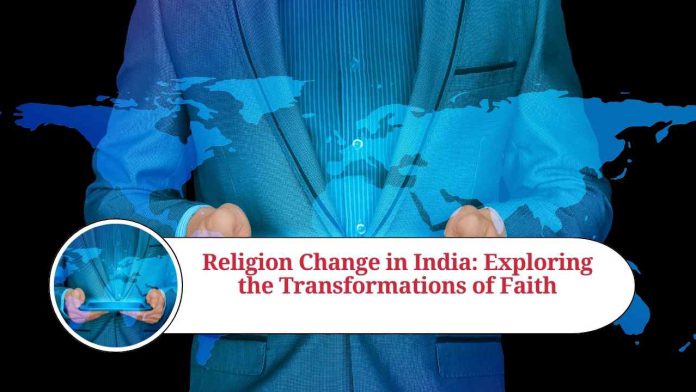Introduction:
India, known for its rich cultural tapestry, has been a land of diverse religious traditions for centuries. Over time, the religious landscape of this ancient nation has witnessed significant transformations, reflecting social, political, and historical influences. In this blog, we explore the fascinating phenomenon of religion change in India, shedding light on the reasons behind these shifts and the impact they have had on Indian society.
Historical Context:
India’s religious history can be traced back thousands of years, with Hinduism, Buddhism, Jainism, and Sikhism originating within its borders. These religions have shaped the ethos and values of Indian society. However, the historical narrative of India also includes the arrival and impact of other faiths, such as Islam, Christianity, and Zoroastrianism, due to trade, invasions, and colonialism.
Factors Influencing Religious Change:
- Socio-Political Dynamics: Social and political factors have played a pivotal role in shaping religious change in India. Rulers and empires throughout history have patronized and promoted certain religions, leading to their growth and influence. For example, the Mughal Empire brought Islam to the Indian subcontinent, while the Mauryan Empire embraced Buddhism.
- Interfaith Interactions: India’s religious diversity has fostered interactions, dialogue, and exchange among different faiths. Such interactions have often led to religious syncretism, the blending of beliefs and practices, resulting in the formation of new religious traditions. This is evident in movements like Bhakti and Sufism, where elements from Hinduism and Islam fused together.
- Conversion and Proselytization: Conversion has been another significant driver of religious change in India. Both voluntary and forced conversions have occurred throughout history, often as a result of religious missionaries, rulers, or personal spiritual quests. These conversions have led to shifts in demographics and the rise of minority religions within certain regions.
- Globalization and Modernization: The forces of globalization and modernization have also had a profound impact on religious change in India. Increased mobility, exposure to different cultures, and the spread of technology have facilitated the exchange of ideas and beliefs. This has opened new avenues for religious exploration, leading some individuals to adopt alternative faiths or adopt new interpretations of existing religions.
Impact on Indian Society:
- Pluralism and Tolerance: India’s religious diversity has fostered a spirit of pluralism and tolerance. Despite occasional tensions, the majority of Indians celebrate and respect the various religious traditions coexisting in the country. The pluralistic nature of Indian society has become a source of national pride and a testament to its cultural richness.
- Communal Harmony and Conflict: While India has a long history of religious coexistence, there have also been instances of religious tensions and conflicts. Friction between different religious communities, often fueled by political or social factors, has occasionally marred the social fabric of the nation. However, efforts towards interfaith dialogue and communal harmony continue to be important for maintaining peace and unity.
- Secularism and State Policies: India’s Constitution upholds the principle of secularism, aiming to provide equal rights and protection to all citizens regardless of their religious beliefs. The state plays a vital role in ensuring religious freedom, preventing discrimination, and safeguarding the interests of minority communities. Government policies have been instrumental in shaping the dynamics of religious change in the country.
Conclusion:
India’s religious landscape has evolved and adapted over time, reflecting the complexities of its history, culture, and society. The interplay of socio-political dynamics, interfaith interactions, conversion, and globalization have influenced the religious fabric of the nation. As India continues to progress, it is essential to foster an environment of understanding, respect, and coexistence among different religious communities, ensuring that religious change remains a source of enrichment rather than division.
Frequently Asked Questions (FAQs)
How diverse is the religious landscape in India?
India is incredibly diverse when it comes to religion. The country is home to several major religions, including Hinduism, Islam, Christianity, Sikhism, Buddhism, and Jainism, among others.
Have there been significant shifts in religious demographics over time?
Yes, there have been notable shifts in religious demographics in India. While Hinduism remains the majority religion, there have been significant increases in the number of followers of Islam, Christianity, and Sikhism over the centuries.
What factors have influenced religious change in India?
Religious change in India has been influenced by socio-political dynamics, interfaith interactions, conversion and proselytization, and the forces of globalization and modernization.
Are there instances of religious syncretism in India?
Yes, religious syncretism is prevalent in India. It is often witnessed in the blending of beliefs and practices between different religions, leading to the emergence of unique religious traditions.
How has religious conversion impacted Indian society?
Religious conversions, both voluntary and forced, have shaped the religious landscape and demographics of India. They have resulted in the growth of minority religions and influenced social dynamics.
What role has the government played in religious change?
The Indian government promotes secularism and has policies in place to protect religious freedom and prevent discrimination. It plays a crucial role in shaping the dynamics of religious change and maintaining communal harmony.
Are there challenges and conflicts related to religious change in India?
While India celebrates religious diversity, there have been instances of religious tensions and conflicts throughout history. Factors such as political manipulation and social tensions can sometimes lead to communal discord.
How does religion impact Indian society and culture?
Religion has a profound impact on Indian society and culture. It influences social practices, traditions, festivals, art, music, and even culinary traditions, creating a vibrant tapestry of diverse cultural expressions.
Is there a tradition of religious tolerance in India?
Yes, India has a long-standing tradition of religious tolerance. Despite occasional conflicts, the majority of Indians embrace the idea of religious coexistence and celebrate the diversity of religious beliefs and practices.
What is the future outlook for religion in India?
The future outlook for religion in India is likely to involve continued coexistence, interfaith dialogue, and the potential for further shifts in religious demographics due to factors such as urbanization, globalization, and individual spiritual quests.




















